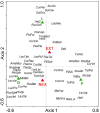Management After Windstorm Affects the Composition of Ectomycorrhizal Symbionts of Regenerating Trees but Not Their Mycorrhizal Networks
- PMID: 34054889
- PMCID: PMC8160286
- DOI: 10.3389/fpls.2021.641232
Management After Windstorm Affects the Composition of Ectomycorrhizal Symbionts of Regenerating Trees but Not Their Mycorrhizal Networks
Abstract
Due to ongoing climate change, forests are expected to face significant disturbances more frequently than in the past. Appropriate management is intended to facilitate forest regeneration. Because European temperate forests mostly consist of trees associated with ectomycorrhizal (ECM) fungi, understanding their role in these disturbances is important to develop strategies to minimize their consequences and effectively restore forests. Our aim was to determine how traditional (EXT) and nonintervention (NEX) management in originally Norway spruce (Picea abies) forests with an admixture of European larch (Larix decidua) affect ECM fungal communities and the potential to interconnect different tree species via ECM networks 15 years after a windstorm. Ten plots in NEX and 10 plots in EXT with the co-occurrences of Norway spruce, European larch, and silver birch (Betula pendula) were selected, and a total of 57 ECM taxa were identified using ITS sequencing from ECM root tips. In both treatments, five ECM species associated with all the studied tree species dominated, with a total abundance of approximately 50% in the examined root samples. Because there were no significant differences between treatments in the number of ECM species associated with different tree species combinations in individual plots, we concluded that the management type did not have a significant effect on networking. However, management significantly affected the compositions of ECM symbionts of Norway spruce and European larch but not those of silver birch. Although this result is explained by the occurrence of seedlings and ECM propagules that were present in the original forest, the consequences are difficult to assess without knowledge of the ecology of different ECM symbionts.
Keywords: disturbances; diversity; ectomycorrhizal fungi; exploration types; mycorrhizal networks.
Copyright © 2021 Veselá, Vašutová, Edwards-Jonášová, Holub, Fleischer and Cudlín.
Conflict of interest statement
The authors declare that the research was conducted in the absence of any commercial or financial relationships that could be construed as a potential conflict of interest.
Figures




Similar articles
-
Management regime is the most important factor influencing ectomycorrhizal species community in Norway spruce forests after windthrow.Mycorrhiza. 2018 Apr;28(3):221-233. doi: 10.1007/s00572-018-0820-5. Epub 2018 Jan 19. Mycorrhiza. 2018. PMID: 29352412
-
Morphological plasticity of ectomycorrhizal short roots in Betula sp and Picea abies forests across climate and forest succession gradients: its role in changing environments.Front Plant Sci. 2013 Sep 2;4:335. doi: 10.3389/fpls.2013.00335. eCollection 2013. Front Plant Sci. 2013. PMID: 24032035 Free PMC article.
-
Forest microsite effects on community composition of ectomycorrhizal fungi on seedlings of Picea abies and Betula pendula.Environ Microbiol. 2008 May;10(5):1189-201. doi: 10.1111/j.1462-2920.2007.01535.x. Epub 2008 Feb 3. Environ Microbiol. 2008. PMID: 18266759
-
Ectomycorrhizal fungal communities in young forest stands regenerating after clearcut logging.New Phytol. 2003 Mar;157(3):399-422. doi: 10.1046/j.1469-8137.2003.00698.x. New Phytol. 2003. PMID: 33873397 Review.
-
Ectomycorrhizal associations in the tropics - biogeography, diversity patterns and ecosystem roles.New Phytol. 2018 Dec;220(4):1076-1091. doi: 10.1111/nph.15151. Epub 2018 Apr 24. New Phytol. 2018. PMID: 29689121 Review.
Cited by
-
Responses of a soil fungal community to severe windstorm damages in an old silver fir stand.Front Microbiol. 2023 Nov 10;14:1246874. doi: 10.3389/fmicb.2023.1246874. eCollection 2023. Front Microbiol. 2023. PMID: 38029204 Free PMC article.
-
The impact of anthropogenic transformation of urban soils on ectomycorrhizal fungal communities associated with silver birch (Betula pendula Roth.) growth in natural versus urban soils.Sci Rep. 2023 Dec 2;13(1):21268. doi: 10.1038/s41598-023-48592-6. Sci Rep. 2023. PMID: 38042912 Free PMC article.
References
-
- Agerer R. (1991). “Characeterisation of ectomycorrhizae,” in Techniques for the study of mycorrhiza, eds Norris J. R., Read D. J., Varma A. K. (London: Academic Press; ), 25–73.
-
- Agerer R. (2001). Exploration types of ectomycorrhizae. Mycorrhiza 11 107–114.
-
- Agerer R., Rambold G. (2004–2015). DEEMY – an Information System for Characterization and Determination of Ectomycorrhizae. Available online at: http://www.deemy.de (accessed November 20, 2019).
LinkOut - more resources
Full Text Sources
Other Literature Sources
Miscellaneous

